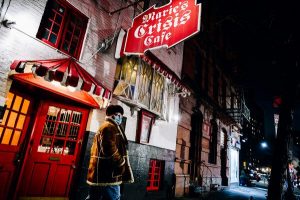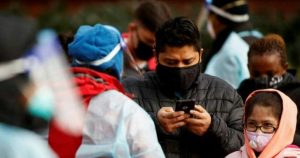California hospitals are preparing to receive the first batch of COVID-19 vaccines as soon as Monday after they were greenlighted by the U.S. Food and Drug Administration.
It’s a welcome glimmer of hope as the state continues to grapple with an unprecedented surge in new coronavirus cases and related hospitalizations that has shattered records nearly every day this week, raising fears that the wave of patients could overwhelm the healthcare system.
Hospital intensive care capacity fell to zero in the San Joaquin Valley on Saturday, a troubling sign that in some places, the threshold for collapse might already have been crossed.
Trucks transporting the first shipments of vaccines in the United States will begin rolling out Sunday morning, delivering on Monday several million doses to 150 locations in numerous states, officials said Saturday.
The vaccine developed by Pfizer Inc. and BioNTech will reach an additional 450 locations Tuesday and Wednesday, Army Gen. Gustave F. Perna of Operation Warp Speed, the Trump administration’s vaccine development program, said in a news conference in Washington.
The massive distribution operation, which Perna described in military logistical terms, will involve UPS and Fedex, working with California and other local governments nationwide. He likened Saturday’s announcement to D-day, the turning point in World War II.
“I am absolutely 100% confident that we are going to distribute safely this precious commodity, this vaccine, needed to defeat the enemy COVID,” Perna said.
Initial shipments of about 3 million shots are expected to leave Pfizer’s manufacturing plant in Kalamazoo, Mich., via truck and then be flown to hubs around the country. A similar amount is to be held in reserve for patients’ second dose.
California is expected to receive about 327,000 doses of the vaccine, which was granted emergency use authorization by the FDA on Friday evening after it “met the FDA’s rigorous scientific standards for safety, effectiveness, and manufacturing quality,” said FDA Commissioner Dr. Stephen Hahn. The vaccine had already been approved in other countries, including the United Kingdom and Canada.
“The FDA’s authorization for emergency use of the first COVID-19 vaccine is a significant milestone in battling this devastating pandemic that has affected so many families in the United States and around the world,” Hahn said in a statement released Friday.
Dr. Peter Marks, director of the FDA’s Center for Biologics Evaluation and Research, said the vaccine “holds the promise to alter the course of this pandemic in the United States.”
A working group of scientists and experts representing the states of California, Washington, Oregon and Nevada are also reviewing the vaccine separately from the FDA process and will make a recommendation by Sunday, Gov. Gavin Newsom said in a statement.
Still, a very small number of people will receive the vaccine this year, with the initial shipment to California “likely to end up largely in hospital settings,” Dr. Robert Schechter, a medical officer with the California Department of Public Health, told participants in a vaccine advisory panel Wednesday.
Perna said local health authorities would determine who gets the first shots, but generally medical workers and residents in long-term care institutions were being prioritized.
The state Department of Public Health selected at least seven hospitals to receive the first batch of vaccines based on their storage capacity, the relatively high risk of their healthcare populations and their ability to distribute the vaccine in the community once it becomes widely available, UC Davis Health said in a news release.
In Southern California, these facilities include Cedars-Sinai Medical Center, UCLA Health and Rady Children’s Hospital in San Diego. In Northern California, designated hospitals include UC San Francisco Medical Center, Mercy Medical Center in Redding and UC Davis Health in Sacramento.
The hospitals also must be able to store the vaccines at the extremely low temperatures they require: minus 70 degrees Celsius (about minus 95 degrees Fahrenheit).
Officials at hospitals slated to receive the vaccines said they were working to distribute the first doses equitably and in accordance with guidelines issued by federal and local health authorities.
UC Davis Health formed a working group that’s spent several weeks developing a tiered approach to vaccinating employees based on the risk of infection that’s associated with the type of work they perform, the healthcare system said.
In the emergency department, top-tier job classifications include custodial workers, physicians, nurses, first responders and clerks, officials said. The health system says it’s prepared to inoculate up to 400 employees each day.
The shipments of the vaccine can’t arrive in California soon enough. The state on Friday marked another milestone, tallying a cumulative 1.5 million coronavirus cases. The state is adding an average of nearly 29,000 new infections a day, a staggering daily toll. More than 20,700 Californians have died, a state tally eclipsed only by Texas and New York.
COVID-19 hospitalizations in California have reached new highs every day this week, growing to nearly 12,500 patients as of Friday, according to data released Saturday. ICU capacity continued to drop in many regions, with Southern California reporting a capacity of 5.3% Saturday, down from 6.2% a day earlier, the San Joaquin Valley region reporting a capacity of zero, down from 4.5% a day earlier.
In Los Angeles County, which has been particularly hard hit, the number of COVID-19 patients topped 4,000 for the first time since the start of the pandemic, according to data released Saturday.
L.A. County will receive its first shipment of nearly 83,000 COVID-19 vaccines as soon as Monday, according to County Supervisor Janice Hahn. They will first be sent to nine facilities that have ultracold freezers and then distributed to 83 acute care hospitals and administered to healthcare workers based on their level of risk, the county Department of Public Health said.
A doctor at an L.A. County public hospital said healthcare workers are being asked to fill out questionnaires to determine their priority for a vaccine. The questions ask about how closely workers interact with COVID-19 patients and how regularly, as well as about their own personal health conditions and age.
The doctor, who requested anonymity because of lack of authorization to speak to the media, expressed hope that the vaccine would stem the “unrelenting onslaught” of COVID-19 patients flooding hospitals recently.
“Everyone I’ve talked to is waiting on bated breath for their vaccine and then will breathe a deep sigh of relief,” the doctor said Saturday, noting the vaccine was expected to become available to employees Thursday or Friday.
Vaccines will also be sent directly to skilled nursing facilities to be given to staff and residents; other types of long-term care facilities will be able to receive vaccines from CVS and Walgreens through a federal partnership program, L.A. County health officials said.
The county expects to receive two more batches of vaccine in December and then weekly batches during the new year, according to the Department of Public Health.
County health officials said they are planning a three-phase rollout. After the first phase consisting of healthcare workers and institutional residents and staff, the second will focus on essential workers and the third on high-risk groups, including seniors and people with chronic health conditions. Officials were still working out the details of exactly how people would be prioritized within the broad groupings.
Hahn said she hopes that essential workers will begin to be vaccinated by early February.
“This is great news — but we aren’t out of the woods yet,” Hahn said in a statement Saturday.
L.A. Mayor Eric Garcetti echoed those sentiments and warned that people must stay home as much as possible to spare hospitals from exceeding their intensive care unit capacity.
“The worst of this pandemic is not yet behind us. It will take months before many Angelenos get vaccinated, so we’re in for a long, hard winter,” Garcetti said in an email to his constituents sent Saturday morning.
A second vaccine, created by the pharmaceutical company Moderna in partnership with the National Institutes of Health, could be granted emergency use authorization next week, said Schechter of the California Department of Public Health. In total, California expects at least 2 million doses of COVID-19 vaccines by the end of December and approximately 6 million by the end of January, he said.
Times staff writers Ron Lin, Maya Lau, Laura Nelson and Jacyln Cosgrove contributed to this report.


















